Photools IMatch 2020 Review
Introduction
IMatch is a general Digital Asset Management Software. This product by Photools is designed to catalog digital files of any type with an extensive feature-set specialized for images. Operations specific to images include conversion, resizing and watermarking. Over 20 years of development lead to functionality that covers music, videos and documents as well.
This DAM software is a veritable swiss-army knife for cataloging. Even though its core system is based around hierarchical categorization, it seamlessly supports keywords, geolocation and every standard type of metadata: IPTC, EXIF, GPS, XMP and more. IMatch is can also be used to organize files using a complete set of file-system features for copying, moving, deleting and intelligent batch renaming.
Since its initial review 10 years ago, IMatch gained a surprising number of features to optimize associating metadata. Spell-checking and an integrated thesaurus help keep metadata consistent for improved lookup. The UI received a substantial overhaul as well, as detailed below. IMatch is available exclusively for Windows with a one-time cost of $130 USD.

NOTE IMatch is one of a few software reviewed here which is not a replacement for Lightroom since it does not offer complete image processing. It can, however, cooperate with Lightroom and is substantially more capable at cataloging digital files.
Software Review
The IMatch software is highly focused around image cataloging yet it can manage any type of digital file. This desktop software has an incredibly deep feature-set and an unprecedented level of customization which makes it doubly over-whelming at times! Its features are built around a database which represents a catalog of files that can all be searched at once. For the most part, IMatch is non-destructive works properly with read-only media. There are options to write side-cars and even overwrite source files but, thankfully, those are disabled by default and they should remain that way.
Installation & Setup
As is typical with DAM software supporting complex searches, IMatch only manages files that have been imported into its database. This step ensures that all metadata for those files are indexed, while newly assigned keywords, categories, etc get added there too. Installing IMatch is fairly quick but oddly requires a reboot which is unusual, if slightly suspect for an end-user application. There is no reason why a modern desktop application would need to restart the operating system. When launched for the first time, IMatch walks users through the catalog creation process by asking a few simple questions.
Catalog creation is reasonably quick. It takes around one minute to create a new empty catalog on a local disk. A few more minutes are required to import without preview. It took IMatch took 2 minutes and 30 seconds to import 620 images totalling 25GB from a state-of-the-art 3D NAND SATA III SSD. There is also an option to create all previews ahead of time which would take substantially longer but would save time when viewing images later in IMatch. Most DAM software decide in their approach, so it is great that the trade-off is offered.
User Interface
Once files are indexed, IMatch launches its main window with the latest catalog. By default, the user interface is very crowded and rather jarring. This is probably a deliberate choice to showcase plenty of features. Luckily, the interface complexity can be reduced to some extent. Even watching its online tutorials, it is easy to notice that the user interface is often greatly simplified to make videos clearer. After a decent amount of customization, including the removal the Identity Plate which makes the application look bizarrely scaled, here is the main window:
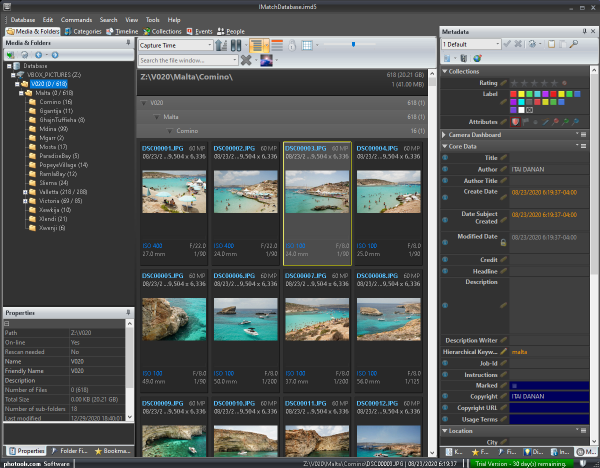
The IMatch interface complexity is off-the-charts! Panels can be anchored on all four sides or onto a central area. Tabs serve to overlap several panes onto each panel. They are all resizable and can be dragged-and-dropped to different areas of the window. Detailed control over colors, views and layouts make nearly any arrangement possible. Certain elements may be scaled up but never down. Even though the application background is uniformly grey, its default palette makes color perception rather difficult since images are highlighted by red frames. Many unused features can be hidden to reduce the visual load. Given its versatility, it is expected that users may not need at features offered.
Several panels have sub-windows which can be collapsed into a tab or title bar, so that other areas can grow. With so many sections inside the main window, the area left to show files and image thumbnails always feels tight. Thumbnails can be shown in various sizes with an highly configurable set of metadata and labels. On the above screenshot, each thumbnail was configured to show its filename, resolution and exposure information plus native focal-length. Nearly any metadata may be shown which makes it easy to see essential information when looking at a set of images.
The visual clutter is the result of an extremely rich set of features. The core concept is hierarchical categories and IMatch includes a few categories based on EXIF metadata to get users started but many more can be created and organized. Keywords are mapped into a special @Keywords category which shows a flat list that maps to assigned keywords. When images are imported, they are automatically added to built in categories. Users can later assign new categories and keywords using various application panel functions.
Search & Filtering
Once files are cataloged, the power of IMatch really shines. There are views to explore images according to their file-system location, Category, Time-Line, Collection, Event or People. File-system and time-line views are completely automated since this information is readily available on disk. Categories start with a handful such as Aperture, Camera, Lens, Type, etc and more can be added later. Collections and Events allow users to arbitrarily group files, while People are indexed using built-in Face-Detection tools. It would be excessively long to cover all these features in detail individually, but they all presented in a similar way.
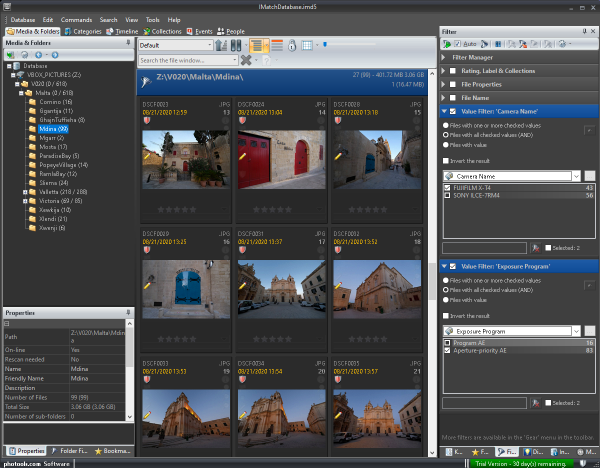
Starting with an initial selection of images in any view, one can very precisely filter images to narrow down the selection. A complementary Filter panel is initialized with a number of expandable sections. Each section groups similar filters, including newer files, ratings, labels, collections and file-names. Multiple additional Value Filter sections can be added to filter on any combination of metadata. For each data-point, a set of values can be included or excluded with an option to require any or all to match.
Filtering is the star feature of IMatch which exceeds the capabilities of any other DAM software in this area. To manage the volume of filtering features, each section in the Filter panel can be collapsed. There are options on how and when to apply each feature which allows users to build complex lookups without constantly triggering updates that can potentially slow down the interface. Most updates happen in a second or two, even when several thousand images are indexed. Just be sure that both Auto at the top and the check box near the filtering section is enabled to see updates live.
Starting with an active set, which can be defined by a folder, category, time-frame, collection, event, etc, files can be selected by applying any number of additional filters. A generic @All collection allows filtering to be applied globally. A similar Database virtual file-system root allows global filtering starting with the Media & Folders view. Selected and enabled filters are applied on the active view by using the Filter pane.
Extra controls allow the exclusion of certain matches to avoid systematic redundancy such as when images exist in multiple formats, called Buddy Files in IMatch. This is most common when having RAW and JPEG versions of the same photo. Since their thumbnail would be identical, hiding one leaves more room to show other images.
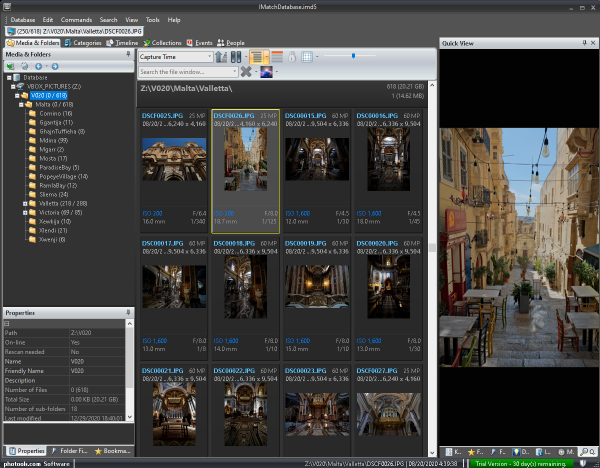
Image Viewer
When thumbnails are unsuitable to inspect images, IMatch offers three possible viewers to show images larger. The Quick View panel, shown above, can be resized to see a better overview of an image. IMatch supports detaching it and even moving the Quick View panel to a second monitor, if available, to give it a large window. One can zoom into the image instantly by clicking on it, but it jumps to 100% and immediately goes back to zoom-to-fit upon releasing the mouse button. This is referred to as Dive Zoom by IMatch documentation. While there could be use-cases for this behavior, it makes it very difficult to inspect images anywhere but near the center of the frame. To stay zoomed in without holding a mouse button down, double-click anywhere on the image. Once the zoom level stays, standard panning behavior applies.
There are several options to adjust the Quick View yet they all feel restricting. That panel is essentially a larger thumbnail which works better for portrait-oriented images which is great documents since those tend to be vertical and rarely need to be inspected so closely as images. Remember, while this review is focused on image cataloging aspects of IMatch, this general DAM software has numerous other uses. Even professional photographers can benefit from support for related non-image files such as model releases, contracts and more.
By default, images are shown in a rather disorienting full-screen viewer. Double-clicking on an image jumps directly out of the IMatch window to cover the entire display area without a title bar or basic controls. It has an unusual panel of digital stickers that is completely out-of-place for photography. While those can be disabled, usability of the full-screen viewer does not improve much.
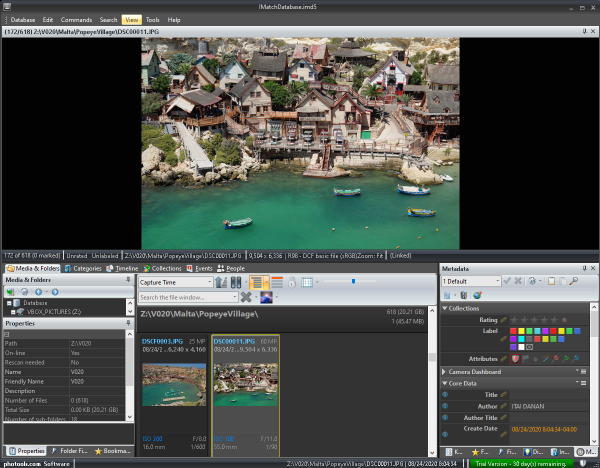
The last and clearly better option is a Panel Viewer which fits into the IMatch user-interface. This view can be docked along any edge of the application window and resized as desired. Although it retains the same awkward controls as other viewers, there is, at least, stability when using this viewer since other elements stay fixed. Several components of the Panel Viewer are customizable and its appearance can be streamlined by removing the Filmstrip which eats up space and is enabled by default. Considering the richer thumbnail view, the filmstrip appears redundant.
Zooming in the Panel Viewer also jumps from one extreme of the zoom to the other. Given that a mouse button must be held down to stay zoomed, it is impossible to drag the image to see towards any edge of the frame. The mouse scroll wheel surprisingly cycles over images instead of zooming, which would have made this interface much more usable. Several bugs were found with viewers during the testing period. One, which occurs with frustrating frequency, causes the viewer to often loses the image appear blank. The other causes high-resolution images to be rendered at a very low resolution. When that happens, zooming only magnifies the preview slightly instead of loading actual image pixels.
Performance
IMatch performance is particularly mixed. Certain functions operate and show results quickly, while others are genuinely sluggish. Its core tagging and searching features are swift but loading images can be painfully slow. It takes 4-8s to load a simple unprocessed JPEG before it gets cached. Jumping to a recently shown image is fast, as long as the image remains in the cache. Unfortunately, it seems like caching lasts a very short amount of time, so be prepared for long sessions when images need to be closely inspected.
Accessing categories or file system paths is on the slow side. It takes a few seconds for thumbnails to change when switching between any of those. Once the set is chosen, filtering down is very quick. Changing filters affects the thumbnail view within one second.
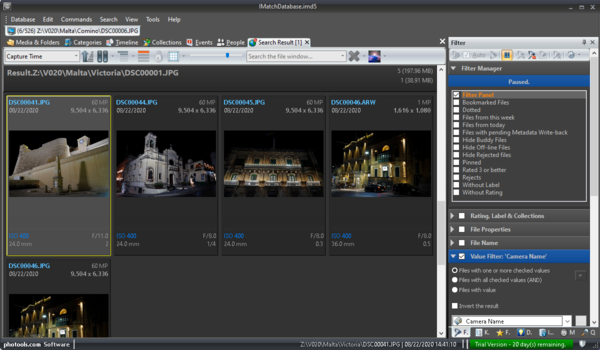
Conclusion
Although IMatch lacks standard image processing capability, it provides a huge number of genuinely useful features. This includes many features to organize files which is traditionally done manually before importing into a photography workflow software. It offers flexible Batch Renaming, Reverse Geocoding, Face-Detection, Image Rotation and much more. Some of its advanced features partially automate cataloging by converting metadata to keywords, for example.
The latest IMatch 2020 version shows significant improvements over the previously reviewed release. While its core concepts remain the same, the interface is more usable and can be optimized with extensive customization. Its level of flexibility is truly unparalleled which gives plenty of opportunities for users to tailor IMatch to their needs. Still, several parts require much more interaction than necessary and keyboard short-cuts are excessively complicated. For complex queries though, this DAM software is clearly in a league of its own.
Please Support Neocamera
All information on Neocamera is provided free of charge yet running this website is a huge endeavor. Purchases made via affiliate links found throughout the site help keep it running and up-to-date. There is no additional cost to you, so please consider buying via these links to our affilates:
Thank you for your support!
Updates
2025.11.13

Best Gifts for Photographers in 2025 by Budget
The annual Neocamera Photography Gift Guide updated to 2025. Find great gifts for photographers with any price budget.
2025.07.07

Stellar Photo Recovery Review
Review of Stellar Photo Recovery V12. This Windows and MacOS software can recover photos and videos in a huge number of formats from memory cards, USB drives, SSDs and HHDs.
2025.05.14

Huion Kamvas 13 Gen 3 Review
In-Depth review of the Huion Kamvas 13 Gen 3 Pen Display Tablet for photographers and graphic artists.
2025.01.18

Fujifilm GFX 2025 Lens Roundup
Lens Review roundup of Fujifilm GFX Medium-Format lenses. Quality, performance and handling of the GF20-35mm F/4R WR, GF30mm F/3.5 Tilt-Shift and the GF55mm F/1.7.
2024.11.18

Best 2024 Photography Gifts for Every Budget
Great gifts for photographers and photo enthusiasts selected for every budget among the best products of 2024.
2024.08.07

Eye Protection Tips for Professional Photographers
The four main considerations for professional photographers regarding eyewear.
2024.07.14

Fujifilm X100VI Review
Flagship fixed-lens compact digital camera with a 40 MP sensor and Image-Stabilization, a first for the series. Retro design featuring dual control-dials, plus direct ISO, Shutter-Speed and EC dials. Its hybrid viewfinder can switch between EVF and OVF mode.
2024.05.09

Fujifilm GFX100 II Review
Flagship 102 Megapixels Medium-Format Mirrorless Digital Camera with 8-Stop 5-Axis IBIS, 8 FPS Drive, 8K Video and 400 MP Super-Resolution capture in a weatherproof and freezeproof body with dual control-dials and dual memory-card slots.
2024.04.03

Fujifilm X-T5 Review
Newest Fujifilm flagship boasting a 40 MP APS-C sensor, 5-axis IBIS with 7-stop efficiency, 15 FPS continuous drive, 6.2K Video capture, dual control-dials and dual SDXC UHS-II slots in a sturdy weatherproof and freezeproof body.
2023.11.20

Best Digital Cameras of 2023
Find out which are the Best Digital Cameras of 2023. All the new Mirrorless Digital Cameras from entry-level to high-end professional.
2023.07.10

Fujifilm X-H2 Review
40 Megapixels APS-C Hybrid Mirrorless Digital Camera with 7-stop IBIS. Fastest shutter ever and 8K video capture. Large builtin EVF with 0.8X magnification and 5.8 MP, plus an Eye-Start Sensor. Packed with features and large number of controls in a weatherproof and freezeproof body.
2023.05.07

Sony FE 20-70mm F/4G Review
Review of the unique Sony FE 20-70mm F/4G lens. The optical zoom of this lens spans ultra-wide-angle and medium focal-length coverage, making it one of the most versatile Full-Frame lenses on the market.
2025.11.13
2025.07.07
2025.05.14
2025.01.18
2024.11.18
2024.08.07
2024.07.14
2024.05.09
2024.04.03
2023.11.20
2023.07.10
2023.05.07
NEWS
2025.12.02

Sony Upgrades Alpha 7 to 5th Generation
Digital Camera ○ Lens
2025.11.29

Venus Optics Releases New Zero-D Tilt-Shift Macro Lens
Lens
2025.11.23

Best Digital Cameras of 2025
Digital Camera
2025.11.14

Photography Gift Guide 2025 Edition
2025.11.06

Canon Announces Third-Generation R6 Mirrorless
Digital Camera ○ Lens
2025.10.23

Fujifilm Launches X-T30 III Plus New Wide Zoom
Digital Camera ○ Lens
2025.10.21

Peak Design Unveils Field Plate and Form Straps
2025.10.16

Nikon Unveils Z-Mount DX Lens Duo
Lens
2025.10.16

Venus Optics Unveils Fast Telephoto Prime Lens
Lens
2025.10.01

Think Tank Photo FocusPoint RollTop Backpacks
Bag
2025.09.30

Sony Produces Super Macro GMaster Lens
Lens
2025.09.17

Venus Optics Created First Telephoto Ultra-Macro Lens
Lens







